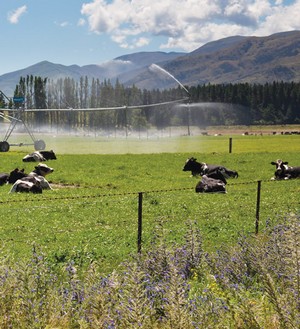Complementary land uses can benefit multiple industries

IO1: Commercial forestry and ecosystem services
Over the past decade, substantial areas of land in the central North Island (CNI) have been converted from forestry to dairy. This has led to changes in the nature of rural jobs and service firms, and a subsequent reduction in water quality and long-term security of log supply for local mills.In 2015, Oji Fibre Solutions and the Waikato Regional Council commissioned Scion to evaluate the effects of land use in New Zealand, using the dairy and forestry industries in the CNI as a case study.
Scion’s Forest Systems Team conducted economic analyses of a representative farm and steady-state forest of the same size, along with their respective supply chains. This project addressed the downstream environmental effects and ecosystem services generated by both industries, and the policies supporting them such as the National Policy Statement for Freshwater Management and the Emissions Trading Scheme. By undertaking a literature review and a simple comparative analysis, the research team was able to use the market and non-market values of the ecosystem services provided by each land use to complete a regional analysis of the relative profitability and value-added created by both industries.
Using average prices for the 10-year period to 2015, the study showed that a hectare of dairy generated about 50 per cent higher returns than forest but comes with a reduction in water quality, higher methane gas emissions and a higher demand for water for irrigation purposes. These environmental costs are not currently factored into the prices charged for dairy products. Conversely, if carbon and nitrogen payments were introduced, forestry would net $16,785/ha compared to $15,216/ha for de-intensified dairy.
The report provides evidence that profitable land use within environmental limits and with lower greenhouse gas emissions can be achieved with better catchment and regional scale planning, and with more incentives for ecosystem services. It also noted that setting appropriate nutrient limits for catchments would promote afforestation and subsequent economic regional growth in a sustainable manner.
“The aim of the study is to provoke and promote constructive discussion on how complementary opportunities can be generated at a farm, catchment or regional level that will be of benefit to both industries,” says Resource Economist Dr Juan Monge. “These discussions will help industry, regional councils and central government to comply with national environmental policies, achieve economic growth within environmental limits, and effectively integrate land uses at different scales.
“We can also apply similar analyses to a wider range of land uses, such as sheep, beef cattle and horticulture.”
The study was independently reviewed and validated by the New Zealand Institute of Economic Research, and the report is available to view on Waikato Regional Council’s website.
Juan and the research team delivered a series of nine presentations on the study to various industry groups and conferences, one of which has been used as an example of sector complementarity analysis on the Morgan Foundation’s website. A peer reviewed article has also been published in the Journal of Environmental Management.
